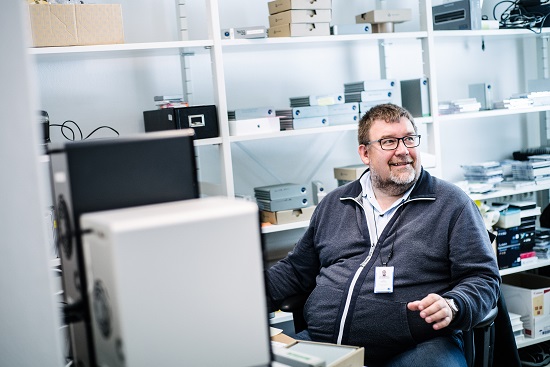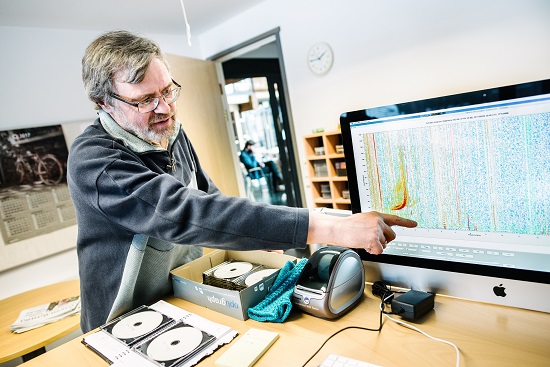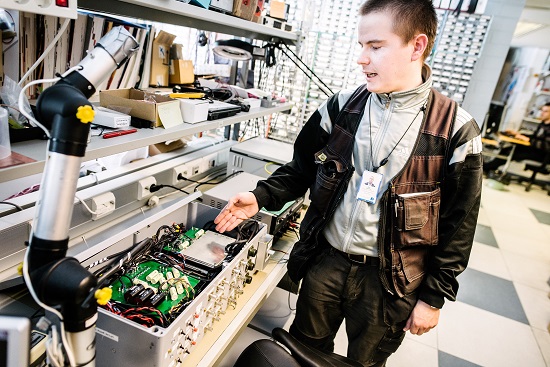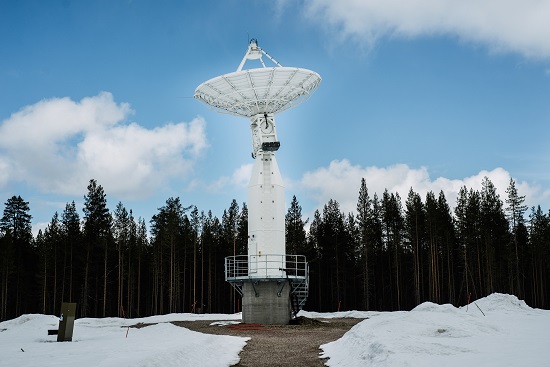The Sodankylä Geophysical Observatory studies everything between heaven and earth. Originally, the scientific community landed in Sodankylä because of the northern lights
The pride of the Sodankylä observatory is super radar with a diameter of 32 metres. When director Esa Turunen came to the Sodankylä research station as a student for the first time in 1984, his job was to analyse the data collected by the radar. It was a dream come true for Turunen.
Seen from the outside the room is just an ordinary office with two computers. Hard disks are heaped up around the computers. There are lots of them, piled into towers, and stacked into long rows on the shelves.
A man is sitting in front of a big iMac screen.
He is the head of laboratory Jyrki Manninen, doing his job: receiving sounds from the space and recording them.
There are CDs full of sounds of the northern lights. In the language of research the sounds are audio frequency radio waves.
Aurora Borealis, the mystical lights of the folktales, are the main reason why, in addition to Manninen, many other researchers have kept coming to Sodankylä for over hundred years already.
The geometry of the endogenous magnetic fields of the earth makes Sodankylä and the whole of Lapland vulnerable to disturbances in the space weather. The poles of earth’s magnetic field are located in the polar regions, and the polar regions are the only places where electrically charged particles are falling into the atmosphere every day and night, sometimes more, sometimes less intensely.
This is when the northern lights lit up the sky, and by studying those lights the researchers in Sodankylä try to predict the future.

The director of the laboratory of the Sodankylä observatory Jyrki Manninen records the sounds of the northern lights, or as the researchers call it, the raw data of the sound frequencies of northern lights. The longest single measurement period lasted for 200 days, from October 2016 to April 2017.
Artificial Aurora Borealis in Inari
Before it became possible to record the radio sounds of the northern lights, the researchers had to solve the origin of this phenomenon.
The story of the International Space Station in Sodankylä began long before man was able to photograph northern lights, let alone launch anything into space.
In 1871 Karl Selim Lemström, docent in physics at the University of Helsinki, decided to go to Inari to solve the mystery of the mechanism of the northern lights. The man, who had studied electrical engineering, was puzzled by electricity in the sky, by lightnings and the northern lights.
Lemström had participated in an expedition in the polar regions to observe the northern lights, and a theory had formed in his mind: What if the northern lights are an electromechanical phenomenon, where the electricity in the air flows into the earth somehow via high mountain tops and that causes the colourful lights in the sky?
Lemström set up a device with spikes sticking upwards on the top of the Luosmatunturi Mountain in Inari. A five-kilometre-long copper wire isolated with zinc was grounded into a nearby swamp.
To Lemström’s chagrin the wire broke and it was impossible to repeat the test because the temperature in Inari was 30 degrees Celsius below zero. At that time it was not yet possible to photograph the northern lights, so evidence was scarce. Lemström, however, insisted that he had succeeded in producing an artificial northern light.
Lemström’s assumptions were not quite correct, but he knew that electricity had something to do with the origins of the northern lights.
There are many different antennae in the vicinity of the observatory to measure the changes in the space weather.
The mechanism of the northern lights was solved only eight decades later when satellites measured the existence of solar winds in the 1950’s. The first photographs with a northern lights camera were taken in 1957.
Before that time the scientific community had not been able to prove that currents of charged particles were flowing from the sun and causing disturbances in space weather and eventually northern lights.
Lemström’s greatest achievement was participating in the very first International Polar Year 1882–1883, during which a magnetic and meteorological observatory was established in Sodankylä. The same place is known today as the Sodankylä Geophysical Observatory. The Polar Year was a significant opening for international cooperation, because until then countries had conducted research by themselves. Now information finally started to flow across borders.
In the magnetic and meteorological observatory over 300 000 observations were made during the Polar Year, that is more than 800 observations every day.
Today the observations are made by devices, and people analyze the collected data. Most of the equipment used in Sodankylä is built on-site.

Northern lights are colourful both in the sky and on computer screen: geophysicist Alexander Kozlovsky working in the observatory is reading his screen to see what is going on in the sky. The orange curve in the lower left corner is a northern light. The screen also tells when northern lights will appear next.
Laboratory technician Pasi Lakkala is one of the builders of the equipment in Sodankylä. He puts together devices that will detect even the slightest vibrations in the magnetic field caused by space weather. In addition to him an international community of some 50 researchers is studying everything between the earth and the sky, space weather included.
At the moment there are several satellites in the sky measuring the space weather and transmitting data to receivers in the polar regions of the world. Near the Sodankylä measuring station there is for example an area surrounded by 24 magnetic loop antennas worth a million euros where each antenna records data once every minute.
This means that each of the loop antennas records data 1440 times per day 365 per year.
The problems of today’s research are the exact opposite of that of Lemström. In his time material was scarce, now the problem is the abundance of information. The devices collect an enormous amount of data from the space each second, but the researchers do not have enough storage space for all the raw data. It will only be saved for a moment.

Specialist laboratory technician Pasi Lakkala is building equipment to help detect even the slightest vibrations in space weather.
Improvements in navigation
The mystery of the northern lights is still not completely solved, but the emphasis of the research in Sodankylä is now on the ways the northern lights change the chemistry of the atmosphere.
Sodankylä and the whole of Lapland are located in a geographically exceptional region: we are especially vulnerable to disturbances in space weather that affect both the atmosphere and the technological systems in space and on earth.
The director of the Sodankylä observatory Esa Turunen says that by studying the variations in space weather we can improve the navigation systems that use satellites in sparsely populated areas, and communication systems in the Arctic regions. In the future communication on ocean liners sailing the Arctic seas will become easier.
”For example you cannot use the navigation system to drive your car into the garage in Kittilä if there are northern lights in the sky. The northern lights mess up the upper layers of the atmosphere and thus affect the satellite navigation system”, Turunen says
Turunen and the other scientists intend to measure the changes that space weather produce in the environment until they are able to derive mathematical models for them.
With the help of the mathematic models we could predict the future and be better prepared for disturbances caused by particles coming from outer space.
Until them many more circuit boards will be put together in Sodankylä to collect data from the sky. The northern lights are not going to disappear.
In addition to breathtaking pictures one can also capture the sounds of the northern lights. Listen to a sample here: https://soundcloud.com/rovaniemi-arcticentre/sets/sounds-of-aurora-borealis
In addition to the Geophysical Observatory also the Finnish Meteorological Institute's Arctic Space Centre is operating in Sodankylä. It has recently expanded from a satellite data centre to a place where the entire chain is handled from the reception of satellite data, to processing and distribution and then the utilisation of data. More information: http://en.ilmatieteenlaitos.fi/

The research station is surrounded by measuring devices. There is also a measurement station of the Finnish Meteorological Institute in the area.
Text: Anna Ruohonen
Photos: Jouni Porsanger